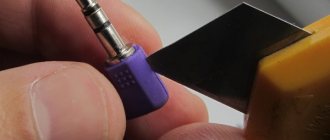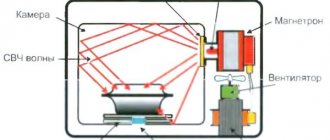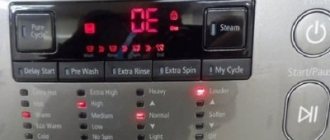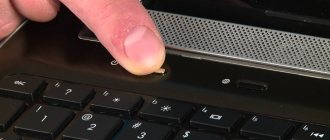Why doesn't the microwave heat up, but the plate rotates and the light is on? The fan is humming and the food is cold. What to do and where to go? When the equipment, which now costs a lot of money and is very necessary in the kitchen, can not be thrown out, but simply repaired, all the knowledge on repairing electrical appliances is used. To achieve a positive result, only basic knowledge of the device itself and microwave electronics is required, or, in extreme cases, the simplest skills of searching for data on the Internet.
There are a number of reasons why the microwave stopped heating and it’s not a matter of broken parts, for example:
- The network voltage has decreased. The operation of the microwave oven, as well as its heating, can be affected by slight decreases of 20V. As a result, the plate will be heated, but there will be no food in the middle of the vessel. The issue of power outages can be resolved in one day: you just need to go to the store and buy a power supply.
- The network is overloaded. If two powerful appliances are running from the same outlet at the same time, an overload occurs. This issue can be resolved by installing another outlet.
- The door is out of order. As a result of a broken latch, the door does not close tightly and the microwave does not heat food or heats it poorly. Here you can try to repair or completely replace the latches.
- Incorrect mode selection. Very often, after defrosting mode, they forget to switch back to microwaves. Defrosting does not heat the food to the required temperature, and you are already about to disassemble the appliance.
The microwave oven does not heat and makes a loud noise
If you find that the microwave oven turns on but does not heat and makes an unusual sound (for example, buzzing), there are 3 explanations for this:
- The diode has become unusable. This part does not allow current to pass in the opposite direction; the current moves only in one direction. If this part fails, the appliance begins to buzz and does not heat the food;
- it's time to change the capacitor. A capacitor failure leads to the generation of waves and the device hums;
- magnetron failure. A defect in this part may also cause a buzzing or humming noise.
The diode has become unusable. This part does not allow current to pass in the opposite direction; the current moves only in one direction. If this part fails, the appliance begins to buzz and does not heat the food; it's time to change the capacitor.
If you decide to find the reason and repair the microwave yourself, then keep in mind that this is a dangerous device. Even if the microwave is unplugged from the network, there is a high probability of electric shock of high voltage, up to 5,000 V. If you have doubts and are not confident in your own knowledge, then it is better to show the device to a specialist, even for diagnostics alone. There is no need to risk your life, because the device is not worth it.
If you nevertheless decide to produce, then before watching anything, turn off the device from the network. Be sure to find the instructions, which contain the names of all the parts that are there.
The microwave has stopped heating and is humming.
If the microwave has stopped heating food properly and is making an uncharacteristic hum, then the reason may be the following:
- Diode failure. Its task is to direct the current in one direction. If a part fails, the microwave begins to buzz and the food does not heat.
- A faulty capacitor causes waves to appear and the device hums.
- Failure of the magnetron can cause buzzing and humming.
High voltage diode
Diode testing is almost never carried out due to its complexity. If it is assumed that the diode caused the device to malfunction, then it is easier to replace it. The test is carried out either by a hum when turned on, or by a blown fuse, or by a capacitor that does not heat up normally.
We recommend: How to install an MDF apron yourself: tips and tricks
High voltage capacitor
If the microwave hums when turned on, it is possible that the capacitor has failed. It's easy to check: connect an ohmmeter and monitor the readings. If the arrow moves, then the capacitor is working; if not, then it is the cause of the breakdown. Please note that replacement or testing occurs only on a charged capacitor.
Magnetron
If all the parts show themselves to be operational, then most likely the problem is in the magnetron. A sign of malfunction is the humming of the microwave when there is no heating. Conduct a visual check for cracks and carbon deposits, measure the values with an ohmmeter. If it is damaged, replace it with one of similar parameters and dimensions.
The microwave does not heat: check the fuse
First of all, after removing the cover, you need to make sure that all fuses are working properly. If you see that they have turned black or the thread has burned out, then you just need to replace them. Often there are two fuse parts inside.
When buying a new part, be sure to take the old (burnt out) one. To temporarily solve the situation, it is not recommended to make bugs out of wire. There is a great danger of fire, and the price of a good fuse is no more than 50 rubles.
If the device hums when turned on, there is a possibility that the capacitor has broken. It’s easy to check its serviceability: you need to take an ohmmeter and connect it to the part. If everything is in order, then the ohmmeter needle moves. And if it stops, then the capacitor has failed, and because of this the stove is noisy.
If the device hums when turned on, there is a possibility that the capacitor has broken. It’s easy to check its serviceability: you need to take an ohmmeter and connect it to the part.
Before replacing or checking the capacitor, it must be completely discharged!
If you notice a burning smell or something crackling inside while the microwave is operating, after watching this video you will understand what’s wrong. It shows how you can repair a microwave oven if it sparks.
Why problems might arise
The main reasons why the microwave stopped heating may be as follows:
- The network voltage has dropped. Sometimes there are power outages and the voltage drops by 20 V. In such cases, the dishes only heat up around the edges, and the food remains cold.
- Network overload. Two high-power devices are simultaneously connected to one power source. This could have a negative impact on the performance of one of them.
- Inappropriate mode set. Most often, this is the “defrost” mode, in which the food does not warm up completely.
- The door is faulty. Perhaps the reason is a broken latch.
These are the simplest options that do not require repairs. But there are more compelling reasons why the microwave does not heat well:
- the timer or control unit is damaged;
- the transformer (high-voltage, light) fuse has blown;
- failure of the electromagnetic lamp, or magnetron;
- pass capacitor is broken;
- The multiplier, consisting of 2 interdependent parts, has failed - a high-voltage diode and a condensate.
It is difficult for a non-professional to determine which parts require replacement. To understand what the problem is, you need to know about possible malfunctions.
Magnetron
If, when checking the device, you did not find any breakdowns, then it is likely that the problem is in the magnetron. The sign by which magnetron failure is determined is strong noise (hum) during operation of the device. If the microwave is humming and not heating, then you need to look at the magnetron to see if there are cracks or carbon deposits there. If the breakdown is not visible visually, then check with an ohmmeter. If the magnetron burns out, then you need to buy the same one. It should have the same parameters and size.
If, when checking the device, you did not find any breakdowns, then it is likely that the problem is in the magnetron. The sign by which magnetron failure is determined is strong noise (hum) during operation of the device.
Preventing damage
We have shared with you information on what to do if the microwave works but does not heat food. It is very important to determine the reason and problem why the microwave stopped heating food. Most often, you don’t have to look for an answer for long: most likely, you used the device incorrectly. In order for your equipment to serve for a long time, you should not do the following:
- heat food in a metal container (a spoon also applies here);
- turn on an empty device (without food);
- warm eggs;
- place containers with lids.
heat food in a metal container (a spoon also applies here); turn on an empty device (without food); warm eggs; place containers with lids.
Over time, any equipment can fail due to wear and tear of spare parts. Equipment made in China can quickly break down due to shoddy assembly; they are used to making quality work only for themselves. If the price of equipment is quite ridiculous, then remember the expression that the miser pays twice. In conclusion of the article, we would like to give you advice: if your microwave oven is under warranty, then under no circumstances open it and do not start looking for a breakdown yourself. Trust qualified employees who will perform diagnostics and carry out work at the expense of the company.
Even if you feel that you can repair the device yourself, know that there is a great danger in any incorrect action. The device has the ability to accumulate electricity and can shock with high voltage. Trust professionals who can determine the problem even just by looking at the device. Your life is much more valuable! Think twice before opening the lid.
Of all the household appliances, the most hard-working one in the kitchen is the microwave oven. It is she who saves our time and helps us out in any emergency situations. Therefore, its unexpected breakdown is very upsetting. What to do if you find that the microwave is not heating?
We do not allow microwave breakdowns
There are a number of rules that will help you keep your microwave oven in working order and prevent breakdowns such as those described. Just follow them, and your device will last you much longer:
- Never heat food in metal containers or containers painted with metallic paint. Gold plated or silver inclusions can also be dangerous. Such paint will immediately begin to sparkle and may even catch fire;
- Do not operate the microwave oven without heating objects inside. This is harmful to the device itself;
- Use a protective cover to avoid rapid contamination of the microwave oven. Especially if you are heating food that tends to "explode" when heated (raw eggs, etc.). Such a lid increases the life of the microwave oven;
- Do not heat food in tightly sealed containers. Hot steam must be able to escape from the container;
- It’s worth taking the furnace to a technician for diagnostics every few years. This is especially true for cheap models, as they fail more often;
- Be careful with mechanical parts. If you slam the door too hard or don't press the button all the way when opening it, you risk breaking the latches.
There is an easy way to check the oven door. Try inserting a sheet of paper through the closed door. If it works, repair is required.
Video: Microwave Oven Care
What malfunctions occur
At some point, you may be upset by a problem - the microwave has stopped heating food. By all signs it is clear that it is broken - it hums, there is no backlight in the chamber, the plate does not spin, the fan does not turn on, the food does not heat up. What to do? You should probably contact a service center to diagnose the problem and make the necessary repairs. If you have experience with electronic equipment, you can try to figure it out yourself.
If the stove is new and under warranty, it is better to simply take it to a service center. Perhaps the malfunction is a consequence of the use of low-quality components and poor factory assembly. In this case, the equipment can be repaired free of charge.
The microwave oven works and does not heat
The situation when the microwave works but does not heat food occurs for many users. How to figure out the cause and what to do if the oven does not hum, the food on the plate is spinning, the ventilation and lighting in the chamber are working. That is, there are all the signs of normal operation, but without the desired result.
The simplest reasons
The microwave will not heat food:
- If there are large voltage drops in the linear network. Already at 200 V, the food in the dish will not heat up completely and will remain cold in the center. To correct the situation, you can use a voltage stabilizer or connect an uninterruptible power supply.
- If the latch on the door is broken and it does not close tightly. It can be repaired or completely replaced.
- When connecting more than two high-power appliances to one outlet. You can additionally make a separate connection.
- If the mode is mistakenly selected incorrectly. For example, they forgot and did not switch it after using the defrost mode.
If the simplest reasons are not suitable for your case, then there is a more serious reason for the lack of heating.
Why does the microwave work but not heat?
If the microwave makes noise but does not heat, this may be due to several reasons:
- Low voltage in the network. If the furnace is running but not receiving enough energy, the magnetron cannot perform its function.
- Damage to the mica plate. Microwaves enter the oven chamber through a special hole covered with a plug. Over time, food debris accumulates on the surface of the latter, preventing the passage of radiation.
- The high voltage fuse has blown. In modern furnaces, an additional protective element is installed next to the magnetron. If it breaks down, the microwave will work, but it will quickly become clear that it is not heating the food.
- The magnetron antenna has failed. Breakage often occurs when the mica plate wears out, when electrical discharges begin to reach, including the element located behind the plug. The microwave works, but does not heat food.
- The capacitor has burnt out. This element in the microwave is located near the magnetron. When the condenser breaks down, the oven often simply refuses to turn on. But sometimes the microwave still works, although it no longer heats the food.
- The high voltage transformer is faulty. The element is responsible for storing energy and supplies the magnetron with high voltage. If it breaks down, the oven works, but does not heat food due to a lack of resources.
Spare parts for repairing microwaves are widely available and are quite cheap. Repairing usually does not require specific knowledge and skills.
To diagnose a microwave oven, you can use a multimeter in ohmmeter mode
Important! Sometimes the microwave works but does not heat due to incorrect settings, for example, if the user set the “Defrost” mode and forgot to switch it back.
Options for more complex problems
The microwave does not heat but it works:
- Due to a breakdown of the control unit and a malfunction of the timer.
- The reason is in the power circuit - in the high voltage diode, capacitor, fuses, high voltage transformer and magnetron.
With some knowledge, you can find and fix the problem yourself.
In case of any breakdown, we must not forget that a microwave oven is a microwave device that operates at ultra-high frequencies and can be dangerous even when turned off.
Troubleshooting
To figure out why the microwave does not heat, you should find one of the reasons that suits your case. After this, the troubleshooting process will be greatly simplified.
Checking the wiring
In good lighting, we make sure that there are no traces of burning on all wires and contacts. We replace the blackened or melted winding, clean the contacts and terminals with a metal brush. You can use fine sandpaper for cleaning.
Oxidized contacts may cause the oven to not operate correctly.
Checking the voltage
Microwave ovens operate reliably at a voltage of 220 V. If the microwave oven does not heat, first of all you need to check the mains voltage. Any working microwave oven will not heat food if the power supply is less than 200 V. What should I do? Connect the uninterruptible power supply.
Checking the serviceability of the door switch
The miniature switch is checked with the back cover of the oven removed using an ohmmeter.
Attention! Be sure to turn off the power to the microwave.
Inspect and check the high-voltage fuse
Upon external inspection, there should be no visible signs of fuse destruction - blackening, characteristic odor, or burnt wire. Using an ohmmeter, or for greater confidence with a tester, we check the resistance of the fuse. If there is slight resistance, we can assume that the situation is not critical.
Doublers status
We measure the capacitor with an ohmmeter. If the arrow does not deviate, there is a break in the device and it needs to be replaced. A small resistance indicates that the capacitor is broken and must also be replaced.
It is better not to check the diode, but to immediately replace it with a new device.
Let's move on to checking the operation of the vacuum tube
Armed with an electrical screwdriver with a protected handle, first of all, by closing the terminals with the housing, we discharge the feed-through capacitors of the lamp. Now you can measure the resistance with an ohmmeter, touching one end of the capacitor terminal and the other to the housing. If the reading fluctuates or is absent at all, the part needs to be changed. The resistance between the contacts is considered normal on the order of 0.1 Ohm.
Transformer primary winding quality
We use a tester to measure the voltage on the winding. When turned on, there should be 220 V. You can check the operation with a simple glass of water. Once you place it in the oven, make sure it is hot. If the water container is cold, it is better to replace the transformer.
The magnetron may be faulty
This is the main part that creates a high-frequency electric field in which the food is heated. You can check the integrity and reliability of the connections of the magnetron with the filter induction coils, feed-through capacitor, and power terminals. If there are problems with this, you can fix them yourself.
What else can you do? Check the filament at the magnetron with a tester. The resistance should be 2–3 ohms. If all of the above is normal, then the microwave does not heat due to a faulty magnetron.
Now all that remains is to buy the failed parts and take the microwave to a specialist. Only in a specialized workshop using special equipment will they be able to make high-quality repairs.
Today it is already difficult to find a person who is not familiar with the work that is used for warming up or. Due to the fact that it, which has become so necessary, is used every day, and sometimes even used incorrectly, problems will arise in the operation of the microwave: it will not heat the food, the plate will not spin in it, or the light will not turn on. Sometimes it even happens that the light is on, the plate is spinning, the fan and grill are running, but the microwave does not heat the food placed inside.
In this article we will analyze in detail the reasons why the microwave does not heat food and what to do about it.
Possible microwave failures
Before you start repairing a microwave oven on your own or hiring specialists, you should determine what kind of malfunction it is:
- The network voltage is less than 220 Volts.
- In inverter microwave ovens, the inverter breaks down.
- Violation in the control circuit: timer or control unit.
- There is a malfunction in the power circuit, consisting of a fuse, a high-voltage diode, a capacitor, a magnetron and a high-voltage transformer.
Causes of microwave failures:
- A metal object gets inside.
- Reheating prohibited foods (such as raw eggs).
- Natural wear and tear of parts.
- A void in the heating chamber that leads to a fire.
Identifying microwave failures and what to do about it?
You can find out the voltage in your outlet where the microwave is connected using a voltmeter, and if it shows that the voltage is really less than the required 220 Volts, you need to install an uninterruptible power supply.
If everything is normal with the voltage, then the microwave is really broken, and the reason why it does not heat should be looked for inside it - in the power circuit:
- Fuse - according to the device diagram attached to the microwave, we find the fuses; if they are blackened or the filament is broken, we simply replace them with the same working ones.
- Capacitor - if it breaks down, a hum or buzzing appears when turned on, the serviceability of the capacitor is checked with an ohmmeter (if the arrow deviates, it is working; if it does not deviate, it is broken). If a malfunction is detected, it should be replaced with a new one, but it must be taken into account that before checking and replacing the capacitor, it must be discharged.
- A high-voltage diode or doubler - an indicator of problems in its operation is the fuse blowing and the appearance of a strong buzzing sound when turned on, since it is very difficult to check it, it is better to replace it immediately with a new one.
- Magnetron - when it malfunctions, you can also hear a hum and buzzing, and when opened, you can see cracks and carbon deposits on the side of it. If its functionality is not visually determined, then using an ohmmeter, we check the feed-through capacitor (it should not be connected to the body of the magnetron itself) and the filament. Having found a problem, we correct it or replace the entire magnetron with one similar or similar in basic design parameters.
If your microwave oven begins to break down almost immediately after it was purchased, it is most likely made from low-quality or defective components.
Whatever the breakdown, you should remember that a microwave oven is one of the most dangerous household appliances and even if not plugged in, it can give a person an electric shock. Therefore, if you do not have the necessary knowledge of electronics, instead of starting to repair the microwave oven yourself, it is better to take it to a specialized workshop.
When equipment breaks down and it is necessary to urgently resolve this issue, every little detail sometimes turns out to be incredibly important. For example, the cause of a breakdown, if it suddenly does not heat, can result in either a serious repair or just a completely trivial problem. In such a case, it would be useful to pay attention to the nature of the malfunction; the details will indicate a likely problem.
Microwave does not heat well - reasons
As soon as you notice that the usual time is no longer enough to warm up or the food remains completely cold, most likely the reason is the so-called magnetron. But this is a rather serious breakdown, we will return to it later. First, let's analyze whether there are any simpler reasons why the microwave stopped heating. And there are enough of them:
- in the network less than 200V (as a result, the radiation power is noticeably reduced, which leads to insufficient heating);
- A common reason why a microwave does not heat is a banal malfunction in the control unit or the timer itself (this is a negligent attitude towards the equipment, its “advanced” age);
- Sometimes the invertron fails (this is a common occurrence for inverter-type equipment);
- The reason why the microwave does not heat well is a problem in the power circuit (the capacitor, diode or fuse may be faulty here).
If the magnetron fails, you will have to give the equipment to a specialist. The reasons why the microwave does not heat due to the magnetron can be malfunctions of various origins.
If the reason why the microwave is not heating food is a faulty diode, you will notice a characteristic buzzing or noise. This indicates that the current only flows in one direction. You will also hear a characteristic hum if the reason why the microwave stopped heating is the capacitor. This section accumulates the field itself, and due to a malfunction, the generation of microwaves does not begin, and this is what gives the same hum. In such a situation, you will have to change some details. That is why it is imperative to give the equipment to a specialist and determine the feasibility of repair, because sometimes this is too expensive.
Some owners of microwave ovens (for example) have encountered the following problem: the device works when turned on, but the food does not heat up. At the same time, the plate rotates, the light is on, even the grill functions, but the food still remains cold or frozen.
Microwave oven device
To facilitate repairs and determine the reasons why the microwave stopped heating but is working, it is worth knowing how it works. Especially about its internal parts.
- The magnetron produces microwaves. A rectangular waveguide connects it to the camera. In certain devices it is covered with a piece of mica. This is a brownish-grayish material that has an external resemblance to metal. Other devices have a plastic cover. The magnetron is powered by a diode, a capacitor and a transformer. The power supply circuit usually contains a high-voltage fuse to protect the transformer from overload.
- A fan is used to cool the hot magnetron. Warm air flows from the magnetron through the air duct into the working chamber. This way the food heats up faster. Steam and excess air escape through special holes that do not allow radiation to pass through.
- Locking microswitches are necessary to prevent the microwave from operating with the door poorly closed. While the door is open, no power is supplied. When it opens, there is an immediate break in the power supply. Often the reason that the microwave does not heat is that these small elements are broken.
- The number of microswitches varies in different models (2-5 pcs.). Sometimes they are used as a power button and power control. An incandescent lamp is needed to provide light in the chamber. It is usually located in the air duct.
- The operating mode is adjusted from the control panel. It has electromechanical switches and is also microprocessor based. Digital control is available with touch or standard buttons. If this is the problem, then it’s not worth understanding electronics without relevant experience. You can only see how the conductors hold on.











